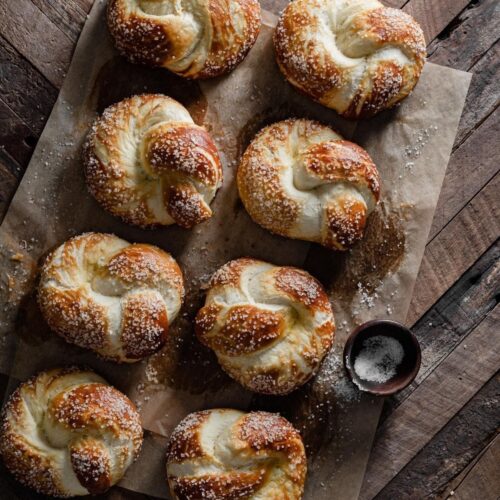Delicious Mediterranean inspired No Knead Olive Bread full of savory olives, roasted garlic, and fresh rosemary. The dough for this easy bread recipe comes together with minimal effort and maximum flavor. Bake in a dutch oven after an overnight dough rest for a deliciously moist olive bread loaf to use for sandwiches, dipping in olive oil or paring with cheese.

No Knead Olive Bread
Most yeast breads takes a bit of work to activate gluten whether you're using a mixer with a dough hook or that good ole arm workout. But, no-knead bread develops gluten by allowing the dough to ferment for a long time, usually 14-16 hrs. The long fermentation creates lot of air bubbles which help the bread to rise while baking.
This type of dough is usually very sticky with a high hydration level and a low yeast content. A perfect homemade bread recipe for beginners or those who want minimal effort to their bread baking.
🌿 Ingredients You Need & Why
- Bread Flour is the flour I recommend for structure and chewiness.
- Active Dry Yeast or Instant Yeast can be used to create pockets of air in the dough, helping the dough to rise when baked and develop an open crumb structure.
- Savory Kalamata and Green Olives are pitted and sliced, then mixed into the dough to provide a lovely Mediterannean flavor profile.
- Garlic Head is roasted in the oven, then the soft garlic is folded into the dough along with the olives for extra flavor. Adding garlic is optional, but so worth it!
- Fresh Rosemary adds a lovely herbal note to the olive bread.
- Cornmeal or Semolina Flour are great options to dust your work surface and create a little additional crunch for a crispy crust.

What is a Dutch Oven?
A dutch oven is a large heavy pot with a lid that traps team around this wet dough allowing for a better rise and expansion of the loaf. I have both a ceramic and a cast iron dutch oven, either will work for this olive bread. This recipe can work in 6-8 quart dutch ovens.


How to Make Olive Bread
This is a minimal hands on rustic bread that anyone can make. All it takes is a little patience to allow the dough to ferment to bale a delicious homemade mediterranean olive bread. You will need to start your recipe the day before you plan to bake it. The dough requires an intial 12-14 hour rest period to activate gas bubbles created by the yeast through fermentation, along with a final 2 hour proof before baking.
Start by roasting the head of garlic and slicing your olives. Whisk together the flour, yeast and salt in a large bowl. Add in the olives, roasted garlic, rosemary and water. Stir together with a wooden spoon to make a sticky dough. Cover the bowl with plastic wrap and set it aside to rest for about 12-14 hours.
The next day, use a dough scraper to transfer the dough onto a well floured surface. Shape the dough into a round loaf using a fold method that rotates the dough back onto itself for 2-3 folds. Transfer the dough to a piece of parchment paper, lower into a large bowl and cover with a tea towel.
A final rest is then needed in a warm place for another 2 hours. The dough will have doubled in size. Take a sharp knife and score the top with a criss cross cut pattern.
Use oven mitts to remove the preheated dutch oven and set it on the counter. Gently lower the dough on the parchment paper into the hot pre-heated dutch oven still and cover with the lid. Bake for 30 minutes, then remove the lid for 15-20 more minutes or until the crust is golden brown.






How to Roast a Head of Garlic
Roasting garlic is super easy and adds a ton of flavor to the dough making this an olive and roasted garlic bread recipe. All you need to do is peel away the outer paper skin form the head of garlic, careful to keep the cloves intact.
Take a sharp knife and cut off the top ¼ of the garlic head to expose the cloves below. Place the head of garlic on a piece of aluminum foil and generously drizzle with olive oil. Wrap the garlic clove up with the foil like a little package.
Place the wrapped garlic head on a baking sheet and bake in the oven at 400℉ / 200℃ / 180℃ Fan (convection) for 30 minutes. Remove the golden garlic head from the foil and let it cool completely before squeezing out the soft roasted garlic cloves.

Baking Tips
What Baking Ingredients I Use and Why
Weigh Your Ingredients:
The recipe card includes both metric and US conversions, but since I create all my recipes with metric measurements, I can't guarantee the same results if you use a different measuring method. This is the kitchen scale I use everyday.
Adjust the Flavor:
Play around with your favorite fresh herbs or mix in a teaspoon or two of za'atar seasoning. A little fresh orange zest also pairs nicely with savory olives, start by mixing in a single teaspoon.
Working With Sticky Dough:
This is a high hydration dough, which makes it very sticky. Don't stress while shaping the dough and avoid adding too much flour to the work surface or it will dry out the dough. Coat your hands generously with flour, or use a bench scraper to fold the dough.
Make Ahead:
Once the dough has been mixed, it can then be covered and allowed to rest in the fridge for up to three days before baking.

frequently asked questions
This bread recipe can be customized using your favorite olives; just make sure the pits are removed and avoid stuffed olives for the best results.
Of course! Bread flour contributes to a chewier final texture, where all-purpose flour lends to a softer loaf. Feel free to swap bread flour evenly for all purpose flour if that's what you have on hand.
Yes, to the freeze the baked loaf, wrap it tightly in either plastic wrap or aluminum foil. Bread can stay frozen for up to 3 months of freshness. Thaw at room temperature before slicing.
you'll also love
Stay in touch with me through social media @ Instagram, Pinterest, and email newsletter to get all the new recipes!

No Knead Olive Bread
Ingredients
Equipment
Method
- Preheat oven to 400℉ / 200℃ / 180℃ Fan (convection). Set aside a small oven proof dish or baking pan.
- Using a sharp knife cut off the top ¼ of the garlic head to expose the cloves beneath. Place the garlic head, cut side up on a piece of aluminum foil.
- Drizzle the garlic generously with olive oil and wrap tightly with the aluminum foil. Place the garlic head in baking dish or on pan, then bake for 30 minutes until the garlic is buttery soft.
- Remove wrapped garlic from the oven and let cool completely. Unwrap the garlic and squeeze out the mashed roasted cloves. Set aside.

- Whisk together the flour, salt, and yeast in a large bowl. Sprinkle the chopped olives, mashed roasted garlic cloves, and rosemary across the flour mixture.

- Pour in the warm water and mix everything together with a wooden spoon or silicone spatula until it forms a wet very sticky dough. Mix the ingredients until all the flour is absorbed for at 1-2 minutes.

- Cover the bowl with plastic wrap and place in a warm draft free location in your kitchen. Allow the dough to rest at room temperature for 12-14 hours. (Overnight rest works bets for baking the next day.)

- The dough should have doubled in size, it be very sticky and full of air bubbles. You should see a web like structure as you dump it out onto the work surface.

- Dust your work surface with a generous coating of flour. Tip the bowl and release the dough onto the flour.
- Generously flour your hands and gently fold the dough 2-3 times to re-enforce the dough and shape into a round loaf.
- Transfer the dough to a parchment paper lined large bowl to rest. Sprinkle a light coating of semolina flour on top. Cover the bowl with a kitchen towel and place in a draft free location to rest for 2 hours.

- After 1 hour of dough resting, preheat your oven to 450℉ / 230℃ / 210℃ Fan (convection) and place the empty Dutch Oven on the middle to lowest shelf to heat for a 45-60 minutes.
- After the full 2 hours of resting the dough should be doubled in size and ready to bake. Score the top of the dough using a sharp knife or bread lame to make a cross-cut on the top of the dough.

- Use oven mitts to carefully remove the preheated dutch oven.
- Gently lower the dough with the parchment paper into the hot dutch oven and place the lid on top.
- Bake the bread for about 35 minutes, then remove the lid and let it bake the final 15-20 minutes uncovered for a nice crust.
- The finished loaf should have a nice golden brown crust.

- Once fully baked, remove the dutch oven from the heated oven.
- Carefully lift the loaf from the dutch oven by pulling up on the parchment paper. Place the olive bread directly onto a wire cooling rack for 10-15 minutes before slicing.
Notes
Tried this recipe?
Let us know how it was! Tag and share on Instagram @twocupsflour















Steph
Hi! Can I use all purpose flour instead?
Carmela S Owens
I have not had good rustic olive bread for over three years since moving to Oklahoma
Natalie
I just made this bread, using the Dutch oven technique, and it was incredible! It tastes and feels like sourdough, so chewy on the inside and crunchy crust on the outside. I can't believe how perfect it came out 🙂 So simple, no oil even. It's wonderful.
Natalie
Forgot to mention that I did use all purpose flour since someone asked.
Lisa
How much would you increase the ingredients to make the bread in an 8 in. diameter dutch oven?
Dionne
This recipe is Amazing. I have followed it numerous times.
The only item that I do differently, is that I add Instant Dry Yeast instead. Cuts down rise to 45 - 60 minute rise time. I did this only because that was the only yeast option style that was available at the grocery store near me. It's been turning out perfect each time. I have made this bread more that 8 times since February. I have some in the oven now. 😄👌🏽💕 So, thank you. I had no idea that my Dutch Oven could do this. Best purchase ever. My Dutch Oven is a Rose Pink Le Creuset. I love the color of yours as well. Great photos. Java Cheers.☕️😃
Carrie
Just made this and it was delicious. Will definitely make again.
Jenn
Yay! I'm so glad:)
Rowena Bryans
I have been looking for good olive bread but couldn’t find any in the local supermarkets and bakeries. I decided to make my own and found this recipe. I never leave comments on recipes BUT I just made this bread and I love it. I will definitely make it again. I used quick rise yeast and didn’t add the rosemary (personal preference). It turned out beautifully. Soft and moist on the inside with a beautiful crust. I’m looking forward to making this bread again with other alterations (no olives) as my son is not a fan.
Rob
Love this recipe. Making it for the second time this morning!
Aviv
Hi! Should I score the bread before baking?